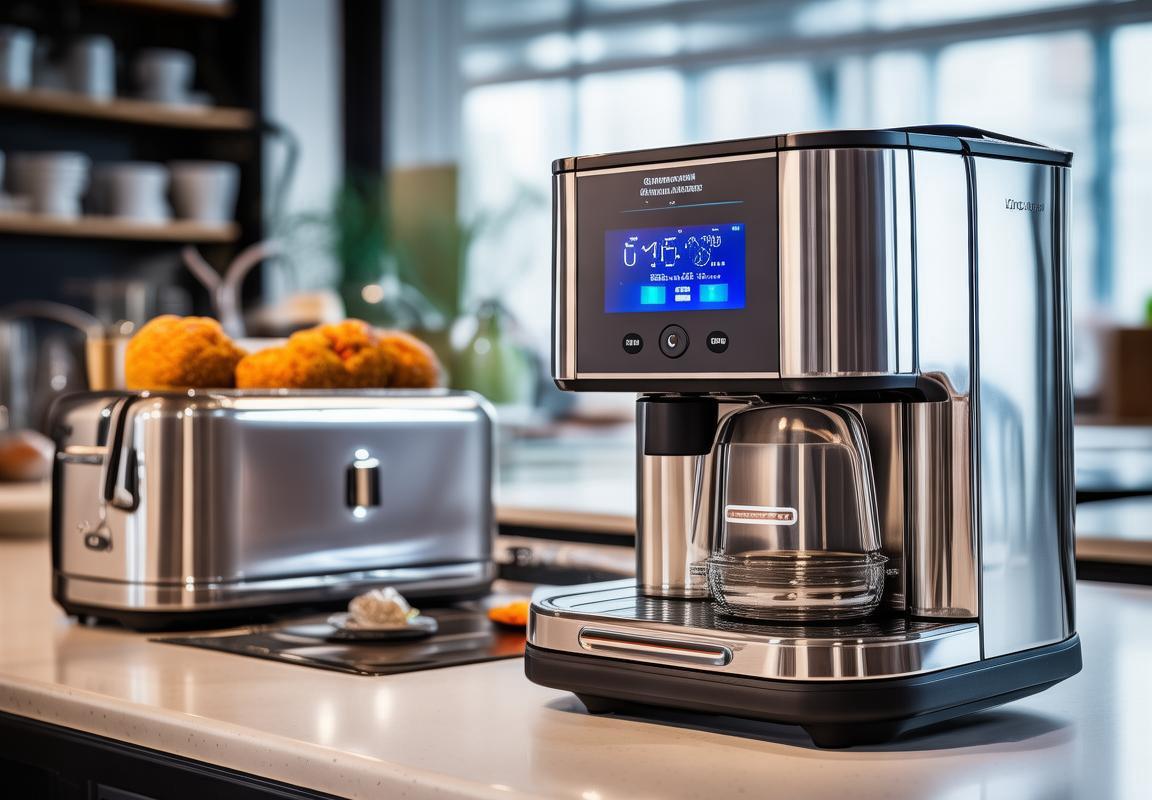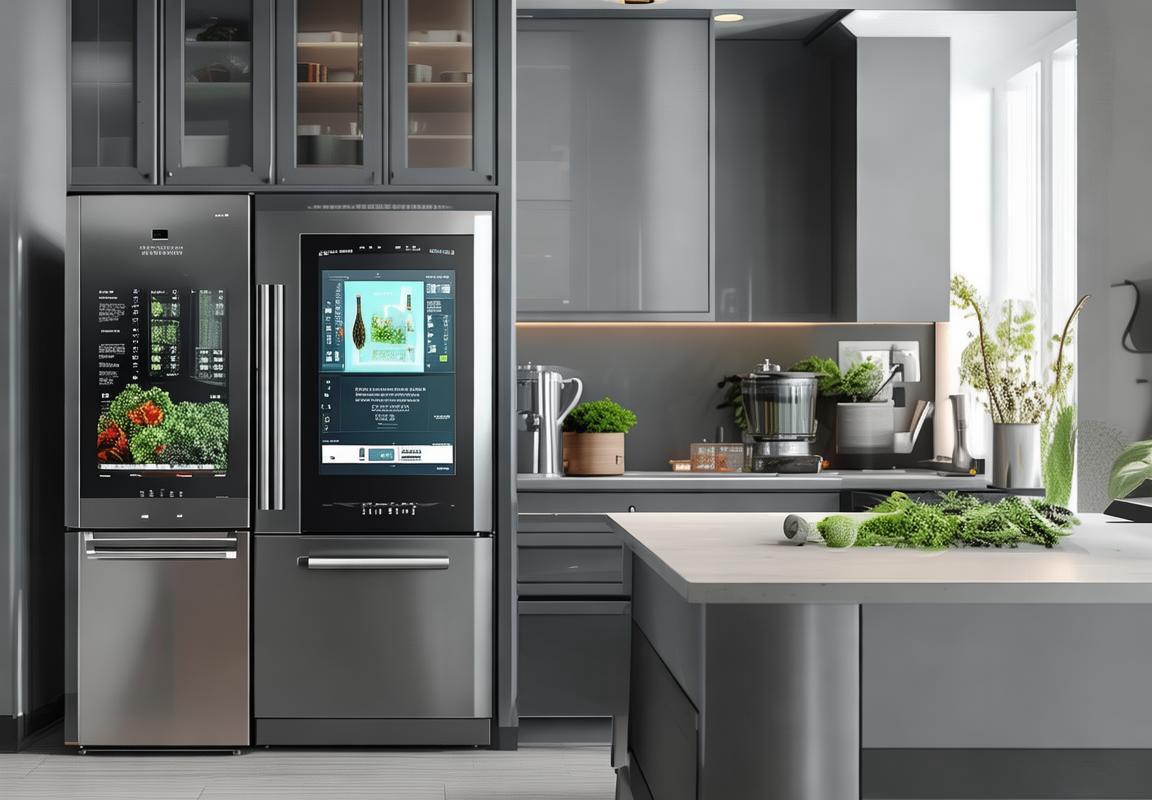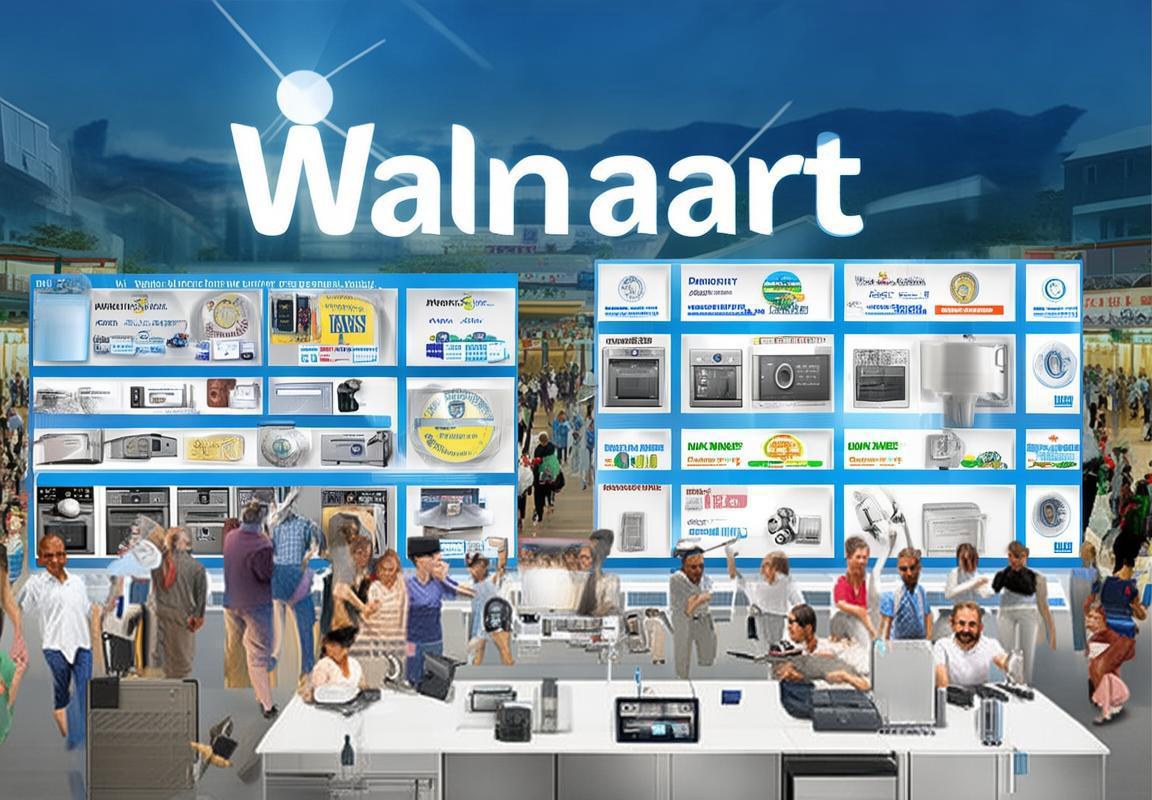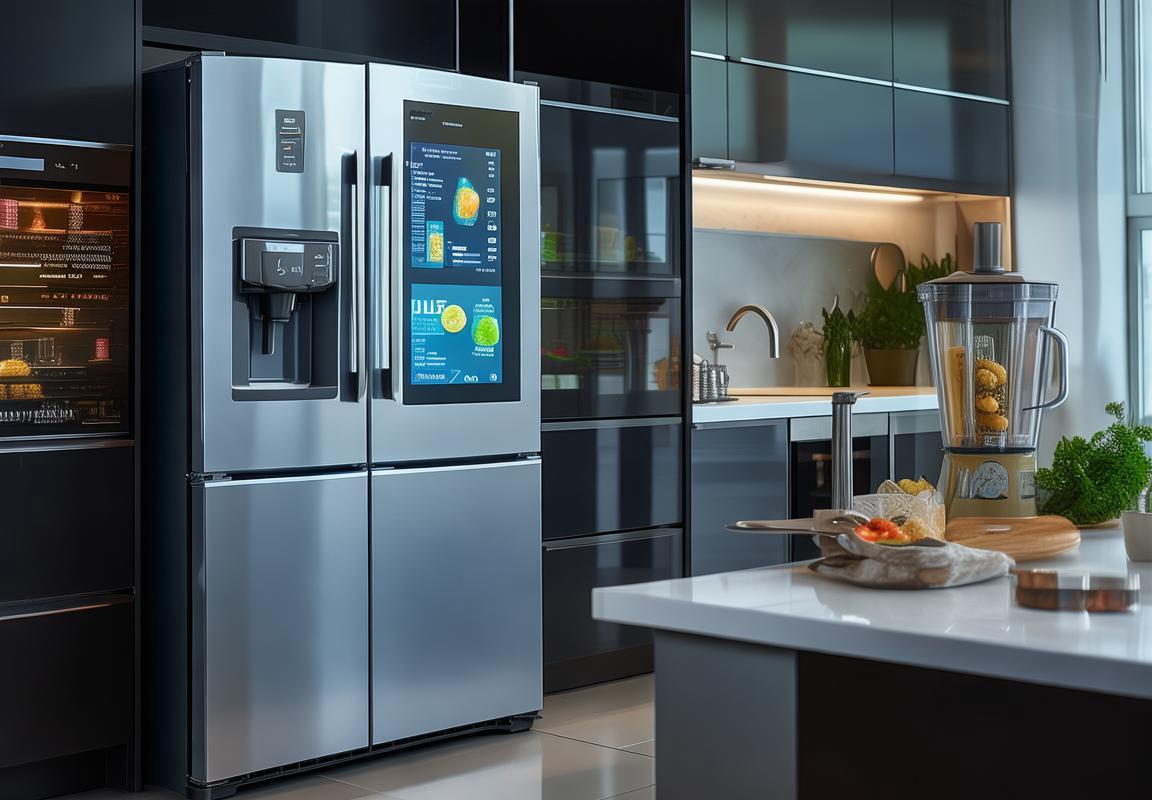In the ever-evolving landscape of consumer electronics, the small appliance market has seen remarkable growth, particularly in the European and American markets. These regions are not just hubs for innovation but also for discerning consumers who demand high-quality, efficient, and stylish kitchen gadgets. Understanding the dynamics at play, the brands that have been recognized by retail giants like Walmart, and the innovations shaping the industry is crucial for anyone looking to navigate the small appliance sector successfully. As we delve into the future, it’s clear that consumer preferences are reshaping market dynamics, presenting both challenges and opportunities for suppliers and manufacturers alike.
The Rise of Small Appliances in Western Markets
The Western markets have witnessed a remarkable surge in the popularity of small appliances. These compact devices, once considered mere conveniences, have now become integral to modern living. From the bustling streets of New York to the serene suburbs of London, these gadgets are not just kitchen tools but also symbols of efficiency and style.
In the past decade, the demand for small appliances has soared, driven by changing consumer lifestyles and a growing emphasis on convenience. The rise of dual-income households and the increasing number of people living alone have created a market ripe for these compact, space-saving devices. Think of the single professional who values a quick coffee fix or the busy family that appreciates a hands-free blender for their smoothie prep.
Smartphones have also played a pivotal role in this trend. With the advent of app-controlled appliances, consumers now expect the same level of connectivity and ease of use from their kitchen gadgets. Smart coffee makers, smart toasters, and even smart ovens are becoming increasingly common in homes, reflecting a broader shift towards smart technology integration.
The European market, in particular, has seen a surge in the sales of small kitchen appliances. Countries like Germany, France, and the UK are leading the charge, with consumers there valuing innovation and quality. In Germany, for instance, there’s a strong preference for appliances that are not only functional but also sustainable, leading to a rise in eco-friendly and energy-efficient products.
In the United States, the market is equally dynamic. The American consumer is always on the lookout for the latest technology, and small appliances are no exception. From air fryers to sous-vide machines, these devices are seen as the latest trends in culinary innovation. The rise of home cooking and baking has also been a significant factor, with appliances like countertop mixers and pasta makers becoming must-have items for many households.
The growth in the small appliance market is not just about convenience; it’s also about the evolution of consumer expectations. Today’s consumers are more informed than ever before, thanks to the internet and social media. They seek out products that are not only high-performing but also stylish and socially responsible. This has led to a rise in niche markets, such as eco-friendly appliances, and a decline in interest for mass-market, low-quality products.
Moreover, the rise of online shopping has democratized access to these small appliances. Consumers can now easily compare prices, read reviews, and make informed purchases without ever leaving their homes. This has led to a more competitive market, with brands constantly striving to differentiate themselves through features, design, and price.
The impact of the COVID-19 pandemic has also been significant. With more people spending time at home, the demand for small appliances has increased as consumers seek ways to enhance their home cooking experiences. From bread makers to air purifiers, these devices have become essential tools for home life.
In conclusion, the rise of small appliances in Western markets is a multifaceted trend driven by changing lifestyles, technological advancements, and consumer preferences. As these markets continue to evolve, it’s clear that small appliances will remain a vital part of the modern home, offering both convenience and innovation.

Understanding the Walmart Approval Process
The Walmart approval process is a rigorous and meticulous endeavor that brands must navigate to gain access to one of the world’s largest retail markets. It involves several stages, each designed to ensure that the products meet the highest standards of quality, safety, and consumer satisfaction.
From the outset, suppliers must demonstrate that their small appliances comply with Walmart’s stringent product specifications. This includes detailed technical drawings, material safety data sheets, and compliance with international safety standards like UL (Underwriters Laboratories) or CE (Conformité Européenne). The process begins with a thorough review of these documents to ensure that the product meets the basic requirements set forth by Walmart.
Once the initial paperwork is approved, the next step is a physical inspection of the product. Walmart’s quality assurance team conducts a series of tests to evaluate the appliance’s durability, performance, and safety features. This can involve drop tests, temperature tests, and even simulated real-world usage scenarios to ensure that the product can withstand the demands of everyday use.
In addition to physical testing, Walmart also scrutinizes the supplier’s manufacturing process. This involves a detailed audit of the production facility to ensure that it meets the retailer’s high standards for cleanliness, efficiency, and quality control. The audit checks for compliance with environmental and labor practices, as Walmart is committed to responsible sourcing and ethical manufacturing.
The supplier’s ability to scale production is another critical factor in the approval process. Walmart requires suppliers to demonstrate their capacity to meet large-volume orders while maintaining product quality. This often means providing evidence of existing production capabilities, including machinery, workforce, and inventory management systems.
After the physical audit, the supplier must also provide proof of compliance with Walmart’s packaging and labeling requirements. This includes ensuring that all packaging materials are sustainable and that the labels contain all necessary information, such as product descriptions, warnings, and barcodes. Walmart’s sustainability initiative is a significant part of its brand identity, and suppliers must align with these principles.
Once all these checks are cleared, the supplier is required to submit a detailed business plan. This plan outlines the supplier’s strategy for meeting Walmart’s demands, including timelines for production, delivery schedules, and customer service protocols. The plan must also account for any potential risks and how the supplier intends to mitigate them.
The final stage of the approval process involves a review of the supplier’s financial stability. Walmart wants to ensure that it can rely on its suppliers to fulfill long-term commitments. This includes an assessment of the supplier’s financial statements, credit history, and payment terms.
Throughout the entire process, suppliers are in constant communication with Walmart’s procurement team. This ongoing dialogue is crucial for addressing any concerns or questions that arise. It also provides an opportunity for suppliers to showcase their commitment to excellence and their willingness to adapt to Walmart’s requirements.
The Walmart approval process is not just about meeting standards; it’s about establishing a long-term partnership. The retailer looks for suppliers who share its values and are dedicated to delivering high-quality products that resonate with its diverse customer base. For those who successfully navigate this process, the rewards can be significant, as being a Walmart-approved small appliance supplier opens doors to a vast market and a strong brand association.
In conclusion, the Walmart approval process is a comprehensive assessment of a supplier’s product, manufacturing, business practices, and financial stability. It is a testament to the supplier’s ability to meet the expectations of one of the most demanding retail markets in the world. For those who rise to the challenge, the opportunity to supply Walmart is not just a seal of approval but a stepping stone to global recognition and success.

Why Walmart’s Approval Matters for Brands
Walmart’s reputation as a retail giant is well-earned, and its stamp of approval carries significant weight in the consumer marketplace. For brands vying for a share of the global retail landscape, obtaining Walmart’s approval as a small appliance supplier is not just a feather in their cap—it’s a strategic move that can open doors to vast new customer bases. Here’s why Walmart’s approval matters for brands:
Branding Powerhouse: Walmart’s brand recognition is unparalleled. When a brand partners with Walmart, it automatically gains credibility. Consumers trust Walmart, and by extension, they trust the products that Walmart chooses to carry. This association can elevate a brand from niche to mainstream, boosting its visibility and appeal.
Global Reach: Walmart operates in multiple countries, including the United States, Canada, the United Kingdom, and China, among others. Being a Walmart-approved supplier means a brand can tap into these diverse markets, reaching millions of potential customers with a single approval.
Economic Stability: Walmart’s financial strength ensures that approved brands have a reliable and consistent sales channel. The retail giant’s purchasing power allows for larger order quantities, which can lead to economies of scale for manufacturers. This stability can be a game-changer for small appliance brands looking to grow and scale their operations.
Customer Insights: Walmart has access to vast amounts of consumer data. By becoming a Walmart supplier, brands gain access to this wealth of information, which can be invaluable for product development and marketing strategies. Understanding consumer preferences and buying habits can help brands tailor their offerings to meet market demands.
Compliance and Quality Standards: Walmart has stringent quality and compliance standards. To become an approved supplier, brands must meet these high benchmarks, which can include safety regulations, environmental standards, and ethical manufacturing practices. This process ensures that brands that carry the Walmart label are delivering high-quality products that meet international standards.
Marketing Support: Walmart provides extensive marketing support to its approved suppliers. This includes co-branded advertising, in-store promotions, and digital marketing initiatives. The exposure through these channels can significantly increase a brand’s market presence and brand recognition.
Strategic Positioning: Walmart’s approval can be a strategic move for brands looking to position themselves as leaders in the small appliance market. It’s not just about the sales; it’s about the perception. Brands that are Walmart-approved are often seen as reliable and trustworthy, which can be a crucial factor in the competitive landscape.
Inventory Management: Walmart’s sophisticated inventory management system ensures that approved brands’ products are well-stocked and readily available. This reduces the risk of stockouts and missed sales opportunities, which is particularly important for seasonal products or those with a limited shelf life.
Brand Expansion: For brands that are already established in certain markets, Walmart’s approval can be a springboard for expansion. It allows them to enter new markets without the need to build a distribution network from scratch, leveraging Walmart’s existing infrastructure.
Customer Loyalty: Walmart’s focus on customer satisfaction is well-known. By aligning with Walmart, brands can benefit from the retailer’s commitment to customer loyalty. This can translate into repeat business and long-term customer relationships for the brands that are part of the Walmart family.
In conclusion, Walmart’s approval is not just a badge of honor; it’s a strategic advantage. It offers brands the chance to tap into a vast customer base, leverage Walmart’s brand power, and gain access to valuable resources and insights. For many small appliance brands, becoming a Walmart-approved supplier is a pivotal step toward achieving significant market success.

Key Trends in the European and American Kitchen Appliance Markets
The European and American kitchen appliance markets have seen a surge in innovation and consumer demand over recent years. Here’s an exploration of some key trends shaping these vibrant sectors.
Smart Technology IntegrationSmart kitchen appliances have become increasingly popular, offering homeowners convenience and efficiency. From smart refrigerators that can track inventory to ovens that can be controlled via smartphone apps, the integration of smart technology has revolutionized how consumers interact with their kitchenware.
Energy Efficiency and SustainabilityWith environmental concerns on the rise, energy efficiency has become a cornerstone of the kitchen appliance market. European and American consumers are gravitating towards appliances that not only save energy but also promote sustainability, such as induction cooktops and dishwashers with eco-friendly wash cycles.
Health and Wellness FocusThe health and wellness movement has extended into kitchen appliances, with a growing interest in products that support a balanced diet and active lifestyle. High-end blenders, juicers, and air fryers have seen a surge in popularity as consumers seek healthier alternatives to traditional cooking methods.
Cooking and Baking InnovationsInnovations in cooking and baking technology continue to captivate the market. From induction cookware that provides precise temperature control to convection ovens that reduce cooking times, these advancements are appealing to both culinary enthusiasts and busy professionals.
Small Appliances as Fashion StatementsOnce considered utilitarian, small kitchen appliances are now seen as fashion statements. Designers are pushing boundaries with sleek, modern aesthetics that complement kitchen decor. This trend has led to a rise in luxury brands offering high-end versions of everyday appliances.
Customization and PersonalizationConsumers are increasingly looking for appliances that can be tailored to their specific needs. This includes programmable coffee makers, adjustable pressure cookers, and refrigerators with customizable temperature zones. The market is responding with more customizable options to cater to individual preferences.
Health and Safety FeaturesSafety and health features are becoming more prevalent in kitchen appliances. From automatic shut-off functions in ovens and stovetops to built-in air filtration systems in dishwashers, these features are designed to protect users and the environment.
Growth of Online SalesThe digital transformation has had a significant impact on the kitchen appliance market. Online sales have surged, with more consumers turning to e-commerce platforms for their appliance purchases. This shift has prompted traditional retailers to enhance their online presence and offer more competitive pricing and convenience.
Global Influence and TrendsThe kitchen appliance market is no longer confined to local preferences. Global trends are influencing consumer choices, with European and American markets adopting products from Asian and South American manufacturers. This cross-pollination of ideas has led to a diverse array of products available to consumers.
Rise of Multi-Functional AppliancesThe desire for space-saving and versatile solutions has driven the development of multi-functional appliances. For example, countertop ovens that can also broil and toast, or multi-purpose countertop prep stations that combine food processor, blender, and juicer functions.
Smart Kitchen EcosystemsAs the internet of things (IoT) becomes more integrated into everyday life, the kitchen is no exception. There’s a growing trend towards creating smart kitchen ecosystems where appliances can communicate and work together seamlessly, providing a cohesive and efficient culinary experience.
These trends reflect a dynamic and evolving landscape in the European and American kitchen appliance markets, where innovation, sustainability, and consumer preferences continue to shape the industry.

Walmart-Approved Small Appliance Suppliers: A Closer Look
Walmart’s stringent approval process has positioned it as a beacon for quality and reliability. As such, becoming a Walmart-approved small appliance supplier is no small feat. Here’s a closer look at what this distinction entails and the attributes that set these suppliers apart.
The Walmart Approval Standards
Walmart’s reputation for excellence in retail is built on the back of its stringent quality control. To gain approval, suppliers must meet rigorous standards that encompass not just product quality but also supply chain management, manufacturing processes, and compliance with regulations. This comprehensive approach ensures that only the best products make it onto Walmart’s shelves.
Certifications and Compliance
A key aspect of Walmart’s approval process involves certifications and compliance with various industry standards. Suppliers must demonstrate adherence to international standards such as ISO, as well as specific Walmart policies, including those related to safety, sustainability, and labor practices. This focus on compliance helps to assure customers that the appliances they purchase are not only high-quality but also ethically produced.
Supply Chain Excellence
Walmart-approved suppliers must also exhibit a high level of supply chain excellence. This means having a reliable and efficient system for production, inventory management, and delivery. Walmart demands transparency and traceability, which are crucial for maintaining the integrity of its brand and ensuring that products are available when customers need them.
Product Innovation and Differentiation
In a market as competitive as kitchen appliances, innovation and differentiation are key. Walmart-approved suppliers often lead the pack in introducing new technologies and designs that appeal to consumers. From energy-efficient models to smart appliances with integrated connectivity, these suppliers understand the importance of staying ahead of the curve to capture market share.
Customer Experience and Satisfaction
The ultimate goal of Walmart’s approval process is to enhance the customer experience. Suppliers that make the cut are those that prioritize customer satisfaction. This means not just manufacturing a great product but also ensuring that it meets the unique needs and preferences of the end-user. Walmart’s approval signifies a commitment to delivering products that are easy to use, durable, and add value to customers’ lives.
Marketing and Branding Support
Being a Walmart-approved supplier comes with significant branding and marketing support. Walmart’s extensive marketing resources can help suppliers increase their visibility and reach a broader audience. This support ranges from in-store promotions to online advertising and social media campaigns, all of which can give suppliers a significant boost in brand recognition and sales.
Long-Term Partnerships
Walmart’s approval process is not just a one-time assessment but a gateway to long-term partnerships. Once approved, suppliers are often given priority for future business opportunities and are included in Walmart’s network of preferred suppliers. This can lead to a stable and consistent revenue stream, as well as the potential for expansion into new markets or product lines.
Commitment to Sustainability
In recent years, sustainability has become a major concern for consumers and retailers alike. Walmart-approved small appliance suppliers are expected to demonstrate a commitment to sustainable practices, from eco-friendly materials to energy-efficient designs. This focus on sustainability not only aligns with consumer values but also positions suppliers as leaders in the green appliance market.
Global Reach and Market Access
For many small appliance suppliers, gaining Walmart approval means gaining access to a global market. Walmart operates in various countries, and being part of its network can open doors to international trade and expansion. This global reach can be particularly beneficial for suppliers looking to establish a presence in new markets or diversify their customer base.
Training and Development
Walmart-approved suppliers are often required to invest in training and development programs for their employees. This ensures that the workforce is equipped with the necessary skills to meet Walmart’s high standards. Additionally, suppliers may receive guidance on best practices for quality assurance, inventory management, and customer service, which can further enhance their operations.
In conclusion, Walmart’s approval as a small appliance supplier is a testament to a brand’s commitment to quality, innovation, and customer satisfaction. It represents a significant achievement and can open the door to a world of opportunities, from increased sales and brand recognition to long-term partnerships and global market access.

Innovations Driving Market Growth
The kitchen appliance industry is constantly evolving, and innovation plays a pivotal role in propelling market growth. From smart technology to sustainable materials, here’s a closer look at the innovations shaping the landscape:
Smart Integration and ConnectivitySmart appliances have become increasingly popular, offering homeowners the convenience of remote control and connectivity. From refrigerators that can monitor food spoilage to ovens that can be preheated via smartphone, the integration of smart technology is transforming how we interact with our kitchen gadgets.
Energy Efficiency and SustainabilityWith growing environmental concerns, energy-efficient appliances are at the forefront of market trends. Manufacturers are focusing on developing products that consume less energy, not only reducing utility bills but also minimizing the carbon footprint. The use of eco-friendly materials and sustainable production processes is also gaining traction.
Miniaturization and PortabilityThere’s a noticeable shift towards smaller, more compact appliances that cater to the needs of urban dwellers and those with limited kitchen space. Mini-fridges, portable blenders, and compact toasters are becoming more popular, as they offer functionality without taking up valuable counter space.
Health and Wellness FeaturesThe kitchen is no longer just a place for cooking; it’s also a hub for health and wellness. Appliance manufacturers are responding to this trend by incorporating features that promote healthier living. For instance, there are now ovens with steam cooking capabilities, which are not only healthier but also preserve the nutritional value of food.
Advanced Cooking TechnologiesInnovations in cooking technology are revolutionizing the way we prepare meals. Induction cooktops, for example, provide precise temperature control and are faster than traditional electric or gas burners. Air fryers and multi-functional ovens are also gaining popularity for their ability to offer a variety of cooking methods in one appliance.
Customization and PersonalizationConsumers are looking for appliances that not only perform well but also reflect their personal style. Customizable appliances, such as those with changeable door panels or finishes, are becoming more common. This trend is driven by the desire for a kitchen that is as unique as the individuals who use it.
Artificial Intelligence and Machine LearningAI and machine learning are beginning to make their mark in the kitchen appliance industry. Smart appliances can learn from user habits and preferences, adjusting settings to optimize performance and energy usage over time. This level of personalization is set to become even more sophisticated as technology advances.
Health Monitoring and Safety FeaturesSafety is a top priority, and manufacturers are responding with appliances that include advanced health monitoring and safety features. For example, smart refrigerators can track the nutritional content of stored foods and alert users to potential foodborne illnesses. Additionally, appliances with built-in safety mechanisms, such as automatic shut-offs and child locks, are becoming standard.
Smart Home IntegrationAs homes become more connected, kitchen appliances are becoming an integral part of the smart home ecosystem. Users can control their appliances through voice assistants, and appliances can communicate with each other to create a seamless kitchen experience. This integration is not just about convenience; it’s about creating a more efficient and harmonious living space.
Eco-friendly Materials and ProductionSustainability is a driving force behind the development of new kitchen appliances. From biodegradable packaging to recycled materials used in the construction of appliances, the industry is moving towards more environmentally friendly practices. This shift is not only beneficial for the planet but also resonates with consumers who are increasingly conscious of their ecological impact.
Custom Cooking and BakingThe rise of personalized cooking and baking experiences is driving innovation in kitchen appliances. From 3D-printed cookie cutters to countertop ovens that can replicate the taste and texture of gourmet pizzas, consumers are seeking appliances that allow them to create unique and high-quality meals at home.
These innovations are not just limited to new products; they are also prompting existing appliance models to be updated and improved. The kitchen appliance market is a dynamic field, and as consumer needs and technological advancements continue to evolve, we can expect to see even more exciting developments on the horizon.

Consumer Preferences and Market Dynamics
In the ever-evolving landscape of consumer electronics, understanding the nuances of consumer preferences and market dynamics is crucial for brands looking to thrive. The kitchen appliance market, in particular, reflects a complex interplay of trends, needs, and expectations. Here’s a closer look at how consumers are shaping the market and what it means for appliance manufacturers.
Smart Technology IntegrationConsumers are increasingly drawn to appliances that offer smart features, allowing for connectivity and control via smartphones or voice assistants. The integration of smart technology in kitchen appliances is not just about convenience; it’s about creating a seamless and efficient home environment. From smart refrigerators that can order groceries to ovens that can be controlled remotely, the demand for smart appliances is on the rise.
Energy Efficiency and SustainabilityAs environmental concerns grow, so does the demand for energy-efficient kitchen appliances. Consumers are not only looking for products that save them money on utility bills but also those that are eco-friendly. The market is seeing a surge in appliances with Energy Star ratings and other sustainability certifications, reflecting a broader shift towards sustainable living.
Health and Wellness FocusThe kitchen has become a hub for health and wellness, with consumers seeking appliances that support their culinary endeavors in creating nutritious meals. This includes everything from high-quality blenders and juicers to slow cookers and air fryers, which offer healthier alternatives to traditional cooking methods. Brands that align with these health-conscious preferences are gaining a competitive edge.
Customization and PersonalizationToday’s consumers want appliances that not only perform well but also cater to their personal tastes and kitchen layouts. Customizable appliances, whether it’s through color options, design choices, or specific features, are becoming more popular. This trend is driven by the desire for a kitchen that reflects the individuality of its users, rather than a one-size-fits-all approach.
Ease of Use and Clean-UpThe convenience factor is paramount. Consumers are looking for appliances that are easy to use and maintain. Features like touch controls, intuitive interfaces, and simplified clean-up processes are becoming standard. The days of complicated appliance controls are fading, and user-friendly designs are becoming a key differentiator in the market.
Digital Experience and ContentBrands are not just selling appliances; they are selling an experience. The integration of digital content and interactive features into kitchen appliances is growing. For instance, smart cookers that offer recipe suggestions and cooking tutorials are appealing to tech-savvy consumers who are interested in enhancing their culinary skills.
Value for MoneyDespite the trend towards premium appliances, many consumers are still looking for value for money. They want high-quality products that won’t break the bank. This has led to the rise of mid-range appliance brands that offer a balance between performance and price, capturing a significant share of the market.
Evolving Shopping HabitsThe way consumers shop for kitchen appliances is also changing. Online sales are on the rise, with more consumers turning to e-commerce platforms for their appliance purchases. The convenience of shopping from home, the ability to compare products easily, and the option for home delivery are all factors that are influencing consumer behavior.
Brand Trust and CredibilityUltimately, the brand behind the appliance plays a crucial role in consumer decisions. Consumers are more likely to purchase from brands they trust and that have a strong reputation for quality and reliability. This trust is often built over time through consistent product performance, excellent customer service, and transparent communication.
In conclusion, the kitchen appliance market is dynamic, driven by a variety of factors including technological advancements, environmental concerns, health consciousness, and changing consumer preferences. Brands that stay attuned to these trends and adapt their offerings accordingly will be well-positioned to meet the demands of today’s discerning consumers.

Case Studies: Successful Walmart-Approved Suppliers
In the competitive landscape of the appliance industry, several suppliers have soared to success by gaining approval from Walmart, a retail giant that sets stringent standards. Let’s delve into the stories of some of these suppliers and what makes them stand out in the market.
In the case of EcoGuru, a company specializing in eco-friendly kitchen appliances, their Walmart approval was a game-changer. Their sleek, energy-efficient blenders and juicers caught the attention of Walmart shoppers, who are increasingly seeking sustainable options. The brand’s commitment to reducing its carbon footprint resonated with consumers, leading to a surge in sales.
Another standout supplier is Kitchy, known for its high-tech kitchen gadgets. Their smart kitchen appliances, such as the internet-connected toaster oven and the voice-activated coffee maker, have been a hit with tech-savvy consumers. Kitchy’s products not only offer convenience but also a unique aesthetic appeal, which has helped them carve a niche in the Walmart marketplace.
GreenGadgets has also found success by focusing on health-conscious consumers. Their range of kitchen appliances, including air fryers and electric grills, has been a hit due to their health benefits and ease of use. Walmart’s vast customer base, which includes a significant number of health-aware shoppers, has helped GreenGadgets expand its reach exponentially.
The story of EasyHome, a supplier of budget-friendly kitchenware, is particularly interesting. By offering a wide array of affordable appliances, EasyHome has become a go-to brand for price-sensitive customers. Their products, which often come with a range of features at a fraction of the cost of other brands, have gained popularity due to Walmart’s ability to reach a broad demographic.
For KitchenCraft, a brand known for its innovative designs, Walmart approval has been a catalyst for growth. Their stylish yet functional kitchen appliances have become a staple in many homes, thanks to their collaboration with Walmart. The brand’s ability to balance form and function has made them a favorite among those looking for a touch of luxury without the high price tag.
In the realm of smart kitchen solutions, SmartChef has made waves with its line of connected appliances. Their intuitive interfaces and seamless integration with home automation systems have captured the interest of tech enthusiasts. By leveraging Walmart’s vast distribution network, SmartChef has been able to bring cutting-edge technology to the masses.
One cannot overlook the impact of KitchenEssence, a supplier that specializes in gourmet kitchenware. Their high-quality bakeware and cookware have been a hit with culinary enthusiasts and professional chefs alike. The brand’s commitment to craftsmanship and attention to detail has allowed them to stand out in the crowded marketplace.
In the world of countertop appliances, CompactKitch has found a loyal customer base. Their compact, space-saving designs are perfect for small kitchens and urban dwellers. Walmart’s approval has helped them gain visibility among consumers seeking practical and efficient solutions for their limited spaces.
The success stories of these Walmart-approved suppliers demonstrate a few key factors that contribute to their growth. Firstly, they have all managed to cater to a specific market niche, whether it’s eco-conscious consumers, health enthusiasts, or tech-savvy shoppers. Secondly, their products offer unique features or benefits that differentiate them from competitors. Lastly, their strategic partnerships with Walmart have allowed them to tap into a vast customer base and leverage the retailer’s extensive distribution network.
By analyzing the strategies and successes of these suppliers, other brands can gain valuable insights into how to achieve similar results. Whether it’s through focusing on sustainability, innovation, or providing value to price-conscious shoppers, these case studies highlight the importance of understanding consumer needs and adapting to market dynamics. In the end, it’s the brands that stay attuned to their customers and offer products that resonate with their values that truly thrive in the appliance industry.

Challenges and Opportunities in the Small Appliance Industry
In the dynamic world of small appliance manufacturing, navigating challenges and seizing opportunities is a constant endeavor. From market trends to technological advancements, the landscape is ever-evolving. Here’s an insight into the multifaceted challenges and opportunities that shape the industry.
The demand for energy-efficient and smart appliances continues to rise, pushing manufacturers to innovate and adapt. Consumers are not just looking for functionality but also for devices that can integrate into their smart homes and offer convenience. This shift has led to a surge in the development of appliances with Wi-Fi connectivity and voice control capabilities.
Safety concerns remain a top priority, especially as new technologies emerge. With the increased use of lithium-ion batteries in portable appliances, there’s a heightened focus on ensuring that these products are safe to use. Brands that can demonstrate compliance with stringent safety standards gain a competitive edge.
The globalization of the small appliance market has introduced new challenges. Suppliers must now compete on a global scale, often with manufacturers in countries where labor and production costs are significantly lower. This competition has led to a need for cost optimization without compromising quality.
On the flip side, opportunities abound. The rise of e-commerce has expanded the market reach for small appliance brands. Consumers can now purchase from a wider range of products and suppliers, which has spurred innovation and variety. Additionally, the growth of online marketplaces has created new avenues for marketing and sales.
Sustainability is another area where challenges and opportunities converge. As consumers become more environmentally conscious, there’s a push for appliances that are not only energy-efficient but also made with sustainable materials. This trend has opened up new markets for eco-friendly products and encouraged manufacturers to explore greener production methods.
Regulatory changes can pose significant challenges but also present new markets. For example, the introduction of new energy-saving regulations has prompted manufacturers to develop appliances that meet these standards. While this requires investment in new technology, it also opens up opportunities in countries where these regulations are in effect.
The integration of artificial intelligence (AI) into small appliances is a game-changer. AI-driven features like predictive maintenance and personalized settings can greatly enhance user experience. However, this also means that manufacturers must invest in research and development to keep up with the rapid pace of technological advancements.
The rise of health and wellness has had a profound impact on the small appliance industry. There’s a growing interest in appliances that can help with fitness, cooking, and overall well-being. This has led to a surge in products like air fryers, smart kitchen scales, and health monitoring devices.
Supply chain disruptions have been a major challenge in recent years. The pandemic highlighted vulnerabilities in global supply chains, making it crucial for manufacturers to diversify their sourcing and reduce dependence on a single region. This shift has opened up new opportunities for suppliers in emerging markets.
Finally, the rise of the gig economy has created a unique opportunity for small appliance suppliers. With more people working from home, there’s an increased need for home office equipment and convenience appliances. This trend has sparked a new wave of innovation in the home office category.
In summary, the small appliance industry is at a crossroads. While challenges such as cost optimization, safety, and regulatory compliance are significant, so are the opportunities presented by technological advancements, changing consumer preferences, and global market dynamics. The key for suppliers and manufacturers lies in embracing innovation, adapting to market changes, and staying ahead of the curve.

Future Projections: What to Expect in the Coming Years
In the ever-evolving landscape of the small appliance industry, it’s clear that the future holds a blend of challenges and opportunities. From technological advancements to shifting consumer behaviors, the next few years promise to reshape the way we think about kitchen gadgets and their role in our daily lives.
The integration of smart technology continues to push the boundaries of what’s possible in small appliances. As connectivity and automation become more prevalent, we can expect to see a surge in products that offer remote control, predictive maintenance, and personalized settings. This not only enhances the user experience but also opens up new avenues for brands to innovate and differentiate themselves in a crowded market.
Consumer preferences are shifting towards sustainability and energy efficiency. With growing environmental concerns, there’s a clear trend towards appliances that are designed to be more eco-friendly, from materials used to manufacturing processes. Brands that can demonstrate a commitment to sustainability may find a loyal customer base that values these ethical considerations.
The rise of health-conscious living is also reshaping the small appliance market. We’re seeing a surge in demand for appliances that can assist with healthy cooking and food preparation, such as air fryers, slow cookers, and sous-vide machines. These products cater to a demographic that seeks convenience without compromising on quality or health.
Innovation isn’t just about new products; it’s also about the evolution of existing technologies. For example, the evolution of blade technology in blenders and food processors has led to more efficient and versatile appliances. Brands that invest in research and development to improve existing technologies may find themselves at the forefront of market trends.
Another opportunity lies in the customization of appliances to meet individual needs. Customization isn’t just about size or color; it’s about functionality. As consumers become more aware of their specific cooking habits and preferences, they’re looking for appliances that can be tailored to their lifestyle. This could mean programmable settings, interchangeable parts, or even appliance subscriptions that offer regular updates and maintenance.
However, with these opportunities come challenges. One of the biggest challenges is the rapid pace of technological change. Brands must stay ahead of the curve to keep up with consumer expectations. This requires significant investment in R&D and a willingness to adapt quickly to new trends.
Regulatory compliance is another challenge, especially when it comes to safety and environmental standards. Brands that want to expand into new markets or appeal to a broader audience must navigate complex regulatory landscapes. This can be costly and time-consuming, but it’s essential for long-term success.
The global supply chain is also a significant challenge. Disruptions can occur at any time due to political instability, natural disasters, or trade disputes. Brands that rely on a global supply chain must be prepared to manage these risks and ensure they can continue to meet demand.
Despite these challenges, there are opportunities for brands to leverage partnerships and collaborations. By teaming up with other companies, brands can share resources, expertise, and market access. This can be particularly beneficial for small and medium-sized enterprises (SMEs) that may not have the resources to go it alone.
In the coming years, the small appliance industry will also be influenced by the rise of e-commerce. Online sales are growing rapidly, and brands that can effectively market and sell their products online will have a significant advantage. This requires a strong digital presence, an understanding of online consumer behavior, and the ability to offer seamless customer service.
Finally, the industry must grapple with the challenge of maintaining a balance between innovation and cost. Consumers are increasingly price-sensitive, and while they appreciate technological advancements, they also expect value for their money. Brands that can deliver cutting-edge features without breaking the bank will likely succeed in the long run.
In summary, the small appliance industry is poised for significant growth in the coming years. While challenges such as technological change, regulatory compliance, and supply chain disruptions loom, so do opportunities for innovation, customization, and e-commerce expansion. Brands that can navigate these complexities and capitalize on the shifting consumer landscape will be well-positioned to thrive in the new era of small appliances.